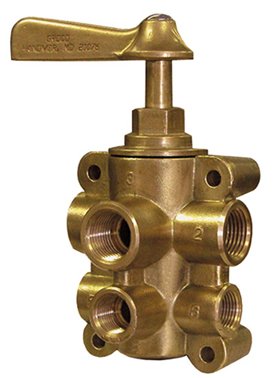Skinny
Senior Member
So my first experience with purchasing my 79' Mainship 34 was it had a decent amount of list to one side. Turns out after further inspection that Mainship only returns fuel to one tank only. That means eventually under normal operation one tank will begin filling the other. Yes...this is pure genious. On a ship that burns maybe 2 gallons an hour under normal cruise, the Perkins 6.354 probably will transfer 50% that consumed volume to the other tank.
I plumbed an additional valve and return into my other tank so that I can change returns. This was a solution to the list issue and a short term fix to "making fuel " while cruising.
" while cruising.
I also would like to stir and clean my tanks since it is not a commercial vessel or out cruising all the time. A polisher would probably be a must but hard to justify the cost of an off the shelf system.
So after much thought process and wanting to plumb a system that would serve many functions along with keeping costs and complexity down...I think this is the one I want to use. Please offer up any tips, tricks, constructive criticism.
I think I am going with the Fleetguard 1000 filter as they are simple spin ons, cost $11, heads are $25, easy/clean to change, still trap water, and are 2 micron. Not as sexy as the Racor 500 that is on it by I honestly believe Racor is more about bragging rights than performance. Certainly not worth the cost and have leaked on me brand new. They have not won me over after multiple purchases and installs. I am very pleased with my Stanadyne FM100 system in my truck. They are twice the price for the head and filter compared to the Fleetguard though. I am also considering eliminating the Perkins manual lift pump or bypassing it since it is original, could fill my crank with diesel if it fails, may require hunting down spares. Normally I like the manual lift pumps but with dual electric Walbros I wouldn't sweat it.


I plumbed an additional valve and return into my other tank so that I can change returns. This was a solution to the list issue and a short term fix to "making fuel
 " while cruising.
" while cruising. I also would like to stir and clean my tanks since it is not a commercial vessel or out cruising all the time. A polisher would probably be a must but hard to justify the cost of an off the shelf system.
So after much thought process and wanting to plumb a system that would serve many functions along with keeping costs and complexity down...I think this is the one I want to use. Please offer up any tips, tricks, constructive criticism.
I think I am going with the Fleetguard 1000 filter as they are simple spin ons, cost $11, heads are $25, easy/clean to change, still trap water, and are 2 micron. Not as sexy as the Racor 500 that is on it by I honestly believe Racor is more about bragging rights than performance. Certainly not worth the cost and have leaked on me brand new. They have not won me over after multiple purchases and installs. I am very pleased with my Stanadyne FM100 system in my truck. They are twice the price for the head and filter compared to the Fleetguard though. I am also considering eliminating the Perkins manual lift pump or bypassing it since it is original, could fill my crank with diesel if it fails, may require hunting down spares. Normally I like the manual lift pumps but with dual electric Walbros I wouldn't sweat it.





 You should never 'blow' through filters for exactly this reason (unless specifically recommended by the manufacturer and I have never seen that)
You should never 'blow' through filters for exactly this reason (unless specifically recommended by the manufacturer and I have never seen that)
